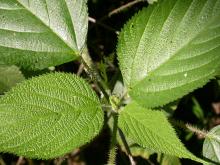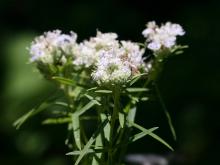Wildflowers, Grasses and Other Nonwoody Plants
Media

Species Types
Scientific Name
Claytonia virginica
Description
Our most widely distributed early spring flower, spring beauty has 5 white or pink petals with distinct pink veining, and 5 pink anthers. The narrow, bladelike leaves are fleshy. These flowers often grow in abundance, covering a patch of ground with the beauty of spring.
Media

Species Types
Scientific Name
Pyrrhopappus carolinianus
Description
One of several native plants called dandelions, Carolina false dandelion is an annual with sulphur yellow flowers and puffy seedheads.
Media

Species Types
Scientific Name
Oxalis stricta
Description
Yellow wood sorrel is both a garden weed and a wild edible. It has a pleasant sour taste, which is why some people call it sourgrass and add it to salads.
Media

Species Types
Scientific Name
Typha spp.
Description
Missouri’s cattails are all tall wetland plants with narrow, upright leaves emerging from a thick base, and a central stalk bearing a brown, sausage-shaped flower spike.
Media

Species Types
Scientific Name
Nelumbo lutea
Description
American lotus is an aquatic plant with circular leaves that are held above water. The large yellow flowers have an interesting showerhead-like disk at the center.
Media

Species Types
Scientific Name
Sagittaria spp.
Description
Arrowheads are aquatic plants with erect, usually arrow-shaped leaves and distinctive three-petaled flowers. They are often called duck potatoes because ducks, geese, and swans relish the tuberlike rootstocks.
Media

Species Types
Scientific Name
Laportea canadensis
Description
Wood nettle, or stinging nettle, often forms dense stands in bottomland forests, streamsides, and other places. There, canoeists, anglers, and others try to avoid touching its stinging hairs!
Media

Species Types
Scientific Name
Daucus carota
Description
Queen Anne’s lace is many things to many people — roadside wildflower, noxious introduced weed, wild edible, medicinal herb, delightful cut flower. In Missouri, it blooms May through October.
Media

Species Types
Scientific Name
Blephilia ciliata
Description
Square, unbranching stems, opposite leaves, two-lipped flowers, and a mild minty fragrance are clues Ohio horsemint is in the mint family. Tight, rounded flower clusters are stacked atop one another at the stem tips.
Media

Species Types
Scientific Name
Pycnanthemum tenuifolium
Description
Slender mountain mint has smooth, square stems, opposite, narrow leaves, and dense heads of 2-lipped white (or lavender) flowers. Aromatic and minty, it can be grown at home in the herb garden, and its leaves used for seasoning food.
See Also
About Wildflowers, Grasses and Other Nonwoody Plants in Missouri
A very simple way of thinking about the green world is to divide the vascular plants into two groups: woody and nonwoody (or herbaceous). But this is an artificial division; many plant families include some species that are woody and some that are not. The diversity of nonwoody vascular plants is staggering! Think of all the ferns, grasses, sedges, lilies, peas, sunflowers, nightshades, milkweeds, mustards, mints, and mallows — weeds and wildflowers — and many more!





















